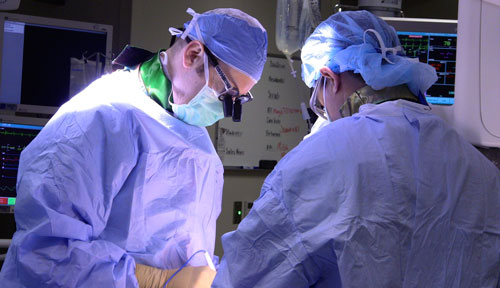Jamie Reynolds is a living reminder of why it’s important to stay on top of your own health.
The 78-year-old grandmother from Omaha always goes for an annual checkup. Her most recent one showed something she neither felt, nor expected — an aneurysm in her aorta.
“I got a CAT scan and an MRI, and that’s where they picked it up,” Reynolds said. “They told me I had an enlarged aorta. I said, ‘What’s that?'”
See Jamie Reynolds’ story here.
Vascular surgeons Matt Longo, M.D., and Jason MacTaggart, M.D., at The Nebraska Medical Center explained to Reynolds that the aneurysm, or bulge in the aorta, the body’s main artery might best be repaired with a new type of minimally invasive surgery — placing a fenestrated graft inside the aorta.
|
|
Reynolds said: “Let’s get busy!”
For several years, medical center surgeons have been repairing aortic aneurysms endovascularly by guiding a fabric and metal mesh graft — a tube used to replace a blood vessel wall — compressed to the width of a pencil, through an artery in the leg. Surgeons position it inside the bulging aorta without doing surgery.
Reynolds’ aneurysm was located where the arteries supplying blood to the kidneys branch off from the aorta. That meant surgeons couldn’t place a conventional graft inside the aorta without cutting off circulation to the kidneys. The fenestrated graft provides “branches” from the main graft that allow blood to continue flowing to the kidneys. Doing such a repair with only two small incisions in the leg is a major advancement.
“Historically, when we’ve seen aneurysms in that area, we’ve been forced to do open aneurysm repair,” Dr. Longo said. “Which involves a big incision on the belly and sometimes the leg. Open surgeries have higher complication rates, longer hospital stays, and usually mean a much, much longer recovery for the patient.”
Reynolds is proud to be the first patient in Nebraska to have this type of procedure done.
“I told my doctor, ‘Oh, I made history?’ And we laugh about it,” she said.
There are several pieces to the fenestrated graft: the main graft that goes inside the bulging aorta, and the side branches that will line the kidney arteries and connect to the main graft. Each graft is custom-made for the patient’s specific anatomy.
“Essentially, we put them together on the inside,” Dr. MacTaggart said. “It’s similar to an erector set we played with as kids.”

I suspect Jason's too young to have had an erector set. Great work, guys!
We're thankful to have provided Jason & Trevor with an erector set…way to go son! – Mom & Dad
Great work Jason. I think what you all are doing is terrific!
Uncle Greg JD (jet doctor)